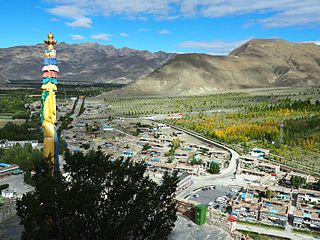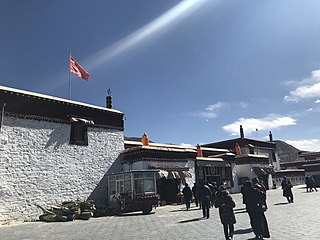
Bhrikuti Devi (Sanskrit: भृकुटी, known to Tibetans as Bal-mo-bza' Khri-btsun, Bhelsa Tritsun, or simply, Khri bTsun was a princess of the Licchavi kingdom in Nepal. In c.622 Bhrikuti became the first wife and queen of the king of Tibet, Songtsen Gampo. Bhrikuti was seen as an incarnation of Green Tara, and is credited for bringing Buddhism to Tibet, together with the Jowo Mikyo Dorje statue for which the Jokhang Temple in Lhasa was built.

Songtsen Gampo, also Songzan Ganbu, was the 33rd Tibetan king of the Yarlung dynasty and he established the Tibetan Empire. As the first of three Dharma Kings of Tibet, he formally introduced Buddhism to Tibet, and built the Jokhang with the influence of his Nepali queen Bhrikuti, of Nepal's Licchavi dynasty. He unified several Tibetan kingdoms, conquored lands adjacent to Tibet, and moved the capitol to the Red Fort in Lhasa. His minister Thonmi Sambhota created the Tibetan script and Classical Tibetan, the first literary and spoken language of Tibet.

The Tibetan calendar, or Tibetan lunar calendar, is a lunisolar calendar, that is, the Tibetan year is composed of either 12 or 13 lunar months, each beginning and ending with a new moon. A thirteenth month is added every two or three years, so that an average Tibetan year is equal to the solar year.

Tri Songdetsen was the son of Me Agtsom, the 38th emperor of Tibet. He ruled from AD 755 until 797 or 804. Tri Songdetsen was the second of the Three Dharma Kings of Tibet, playing a pivotal role in the introduction of Buddhism to Tibet and the establishment of the Nyingma or "Ancient" school of Tibetan Buddhism.

Shannan, also known as Lhoka, is a prefecture-level city in the southeastern Tibet Autonomous Region, China. Shannan includes Gonggar County within its jurisdiction with Gongkar Chö Monastery, Gonggar Dzong, and Gonggar Airport all located near Gonggar town.

Muru Ningba or Meru Nyingba is a small Buddhist monastery located between the larger monasteries of Jokhang and Barkhor in the city of Lhasa, Tibet, China. It was the Lhasa seat of the former State Oracle who had his main residence at Nechung Monastery.

Tsetang or Zedang, is the fourth largest city in Tibet and is located in the Yarlung Valley, 183 km (114 mi) southeast of Lhasa in Nedong District of the Shannan Prefecture in the Tibet region of China. It is the capital of Shannan Prefecture.

Nêdong District is a district of Shannan in the Tibet Autonomous Region, China.

Princess Wencheng was a princess and member of a minor branch of the royal clan of the Tang dynasty, who married King Songtsen Gampo of the Tibetan Empire in 641. She is also known by the name Gyasa or "Chinese wife" in Tibet. Both Wencheng and Songtsen Gampo's first wife, Nepali princess Bhrikuti, are considered to be physical manifestations of the bodhisattvas White Tara and Green Tara respectively.

Yerpa is a monastery and a number of ancient meditation caves that used to house about 300 monks, located a short drive to the east of Lhasa, Tibet.

Tradruk Temple in the Yarlung Valley is the earliest great geomantic temple after the Jokhang and some sources say it predates that temple.
Gungsong Gungtsen was the only known son of Songtsen Gampo, the first Tibetan Emperor and the Prince of Tibetan Empire in Yarlung Dynasty.
Lhamo Latso or Lha-mo La-tso is a small oval oracle lake where senior Tibetan monks of the Gelug sect go for visions to assist in the discovery of reincarnations of the Dalai Lamas. Other pilgrims also come to seek visions. It is considered to be the most sacred lake in Tibet.
Namri Songtsen, also known as "Namri Löntsen" was according to tradition, the 32nd King of Tibet of the Yarlung dynasty. During his 48 years of reign, he expanded his kingdom to rule the central part of the Tibetan Plateau. He also had a good diplomatic partnership with other tribes and Empires. His actions were decisive in the setting up of the Tibetan Empire, to which he can be named co-founder with his son, Songtsen Gampo. He Sieged in Kingdom of Sumpa in early 7th century.

Nyatri Tsenpo was a king of Tibet. He was a legendary progenitor of the Yarlung dynasty. His reign is said to have begun in 127 BC and in traditional Tibetan history, he was the first ruler of the kingdom. The Dunhuang chronicles report that he is said to have descended from heaven onto the sacred mountain Yarlha Shampo. Due to certain physical peculiarities – his hands were webbed, and his eyelids closed from the bottom and not the top – he was hailed as a god by locals, and they took him as their king.

The Tibetan Empire was an empire centered on the Tibetan Plateau, formed as a result of imperial expansion under the Yarlung dynasty heralded by its 33rd king, Songtsen Gampo, in the 7th century. The empire further expanded under the 38th king, Trisong Detsen, and expanded to its greatest extent under the 41st king, Rapalchen, whose 821–823 treaty was concluded between the Tibetan Empire and the Tang dynasty. This treaty, carved into the Jokhang Pillar, delineated Tibet as being in possession of an area larger than the Tibetan Plateau, stretching east to Chang'an, west beyond modern Afghanistan, and south into modern India and the Bay of Bengal.

Sera Utsé Hermitage, Sera Utse, Sera Ütse, Sera Tse or Drubkjang Tse is a historical hermitage belonging to Sera Monastery. It is located on the mountain directly behind Sera Monastery itself, which is about 5 kilometres (3.1 mi) north of the Jokhang in Lhasa, Tibet Autonomous Region of the People's Republic of China. It is older than Sera Monastery.

The Yarlung Valley is formed by Yarlung Chu, a tributary of the Tsangpo River in the Shannan Prefecture in the Tibet region of China. It refers especially to the district where Yarlung Chu joins with the Chongye River, and broadens out into a large plain about 2 km wide, before it flows into the Tsangpo River. It is situated in Nedong District of the Shannan Prefecture and includes the capital of the prefecture, Tsetang, one of Tibet's largest cities, 183 km southeast of Lhasa.

Lhasa is noted for its historic buildings and structures related to Tibetan Buddhism. Several major architectural works have been included as UNESCO's World Heritage Sites.

The Yarlung dynasty, or Pre-Imperial Tibet, was a proto-historical dynasty in Tibet before the rise of the historical Tibetan Empire in the 7th century.



























